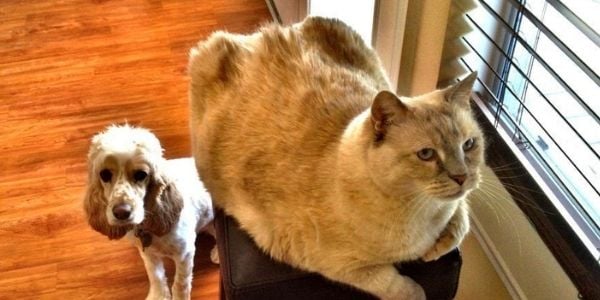
People generally prefer their pets to be a bit "chonky" and not bony. I tend to go against the grain and prefer pets to be on the leaner side of ideal – that doesn’t mean bony, especially obviously bony.
And that doesn’t mean I don’t get sucked into the adorableness of a “roly-poly” pet. But when it comes to judging weight, most pet owners struggle with knowing what a truly healthy weight is.
This is likely why there is such an issue with pet obesity (roughly 60% of pets are overweight or obese).
This inability to properly judge weight makes it hard not only to notice the difference between overweight and ideal weight but also to make the determination between ‘healthy skinny’ and ‘unhealthy skinny.’
Bony Isn’t Just Skinny!
There are many bony pets, like people, who are healthy or have well-controlled health issues.
But there are times when pets who are underweight and bony have undiagnosed health issues, and there are times when pets appear to be normal weight or underweight, but they actually have muscle loss, which causes them to look bony.
To determine what your pet’s fat storage is, it's best to assess a body condition score (BCS) and muscle condition score (MCS) together. Knowing both of these in conjunction is beneficial, and we explain how to assess those below.
When Pets Are Too Skinny, You Will Notice:
- Your pet’s ribs are clearly visible, even at a distance. You will not be able to feel a fat layer between the skin and the ribs.
- Your pet’s spine will be visible, and there will be no fat detectable. There may be mild to obvious muscle loss.
- Just beneath the skin, you can feel your pet’s shoulder bones and hip bones.
- The bones at the base of the tail are obvious and protrude.
- Your pet’s hourglass figure is extreme when viewed from above (like the dog in the photo below).
- When viewing from above, your pet’s spine and ribs are obvious.
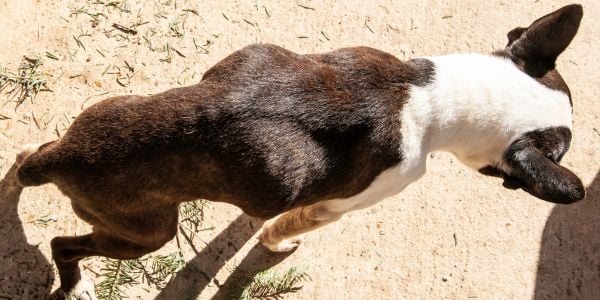
Assess Your Pet's Body Condition Using a Chart
A pet's weight is not necessarily assessed based on pounds or kilograms but instead on a body condition score. Every pet has one. It is always best to have a veterinarian or a certified veterinary nutritionist evaluate your pet’s body condition score, but you can do it using the charts linked below.
A body condition score (BCS) is based on a scale of 1 to 9 (some scales are 1 to 5) and helps determine your pet’s body fat. Numbers don’t lie!
Always weigh your pet when assessing the body condition score. Keeping a continuous record helps you determine weight trends and helps alert you to significant changes sooner.
The Ideal Body Score for Your Dog or Cat
The ideal body score (BCS) for your pet is 4 or 5 (If you happen to have a 1–5 scale, 3 is the ideal). When pets have a body condition score less than 3 (for a 1–5 scale, 2 or less) they are getting too thin and bony.
When your pet falls in this range ideal range, they appear lean, not skinny. They have an obvious waistline when you look down at their back (think hourglass figure!), and their abdomen is tucked up and not sticking out past the rib cage (think of it slanting at an upward angle between the ribs and the back legs). No sagging bellies! Their ribs can be felt, with a light touch, beneath a thin layer of fat.
There are some dog breeds (Sighthounds, Great Danes, Greyhounds) and cat breeds (Devon Rex, Sphynx, Siamese) that are like people and have prominent bony features.
Obviously, if your pet is fluffy, you'll have to feel for these features, as you won't see them as well. But don’t use their ‘fluff’ as an excuse for them being heavier.
Pro Tip: To help you know what to expect when feeling your pet's ribs, try the following exercise.
Make a fist and then use your other hand to feel the knuckles. This is what you should feel when you are touching your pet’s ribs.
Some pets can have medical issues that prevent them from gaining weight, so you'll want to have that diagnosed.
See the list of those medical reasons and other possible causes below.
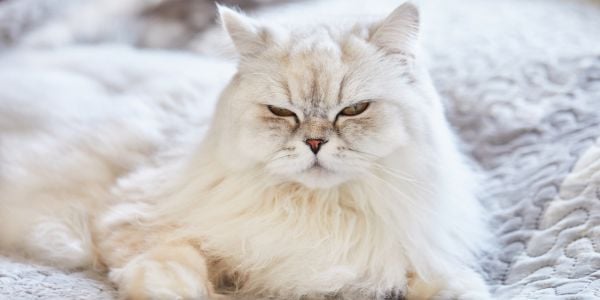
How to Assess Your Pet's Muscle Condition
Like people, as pets age they have muscle loss. Older pets are less able to process protein due to a reduction in growth hormones. This reduction in protein utilization makes it more difficult for them to build and maintain muscle.
So, your pet may be the right body condition, but their loss of muscle makes them look thinner. The best assessment of your pet's "bonyness" is made when the results of the MCS are combined with BCS.
Using the 4-point muscle condition score (MCS) you will use visualization and touch to assess your pet’s muscle mass over their spine, shoulder blades, skull, and hip and then grade each location as normal, mild loss, moderate loss, and severe loss.
This chart shows the four levels of muscle loss and what to look for.
Normal muscle mass: When there is almost no depression in the area when pressed with your finger, or you are unable to pinch up tissue between your thumb and fingers.
Mild muscle loss: You can slightly depress tissue with your dinger or pinch up a small amount of tissue between your thumb and fingers.
Moderate muscle loss: When you can clearly depress tissue with your finger or obviously grab tissue between your thumb and fingers.
Severe muscle loss: When there is a very obvious depression into the tissue with your finger, or you can very easily lift up a section of tissue between your thumb and fingers.
Read our article for more information on muscle loss and what causes it.
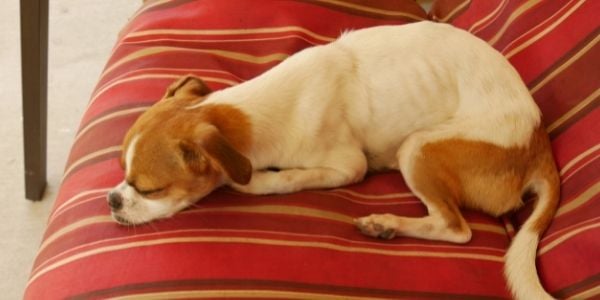
Issues That Can Result in Weight Loss
There are many factors that can result in weight loss. Some of those factors can be treated, and their effects on your pet’s weight can easily be repaired. In contrast, other factors can have long-term effects.
Note: It is critical to seek veterinary advice when your pet’s weight loss exceeds 10% of their prior stable (normal) body weight in a short period or over 15% over a long period of time. That's why keeping records of your pet’s weight trends is beneficial.
A Few Possible Issues That Can Cause Weight Loss
Food issues: This can include poor nutrition (diet isn’t well balanced), picky eaters, inadequate calories for their life stage (for example, puppies need more calories than adult dogs), or anxiety/stress.
Poor quality diet: When your pet’s diet does not meet their nutritional requirements, they will become nutritionally deprived and be unable to maintain weight, muscle mass, or bodily functions. Poor diets can also cause vomiting and diarrhea, which can lead to further nutrient loss.
Inadequate calories to meet physical activity: For example, athletic or working dogs or outdoor cats need more calories and often require more protein to maintain their muscles.
Gastrointestinal issues: Issues such as inflammatory bowel disease, maldigestion/malabsorption (lowered ability of the body to break down and/or absorb nutrients).
Liver Disease: Liver disease causes a loss of appetite. It causes abnormal nutrient digestion, absorption, and metabolism, as well as vomiting and diarrhea. All of these things lead to weight loss.
Kidney Disease (read more about kidney disease in cats)
Diabetes mellitus (read more about diabetes in cats or diabetes in dogs)
Hypoadrenocorticism (Addison’s disease): Pets often experience vomiting and diarrhea as well as a loss of appetite with this disease.
Cancer: As the body responds to the cancer, it produces substances that alter appetite and cause muscle loss. Both of which lead to weight loss. Cancers affecting the gastrointestinal tract, such as lymphoma, can inhibit nutrient absorption and cause malnutrition, resulting in weight loss.
Pain: Arthritis or other illnesses make it hard for pets to get to their food bowls. Additionally, painful pets stop eating.
Hyperthyroidism: This relates primarily to cats. This metabolic disease increases metabolism, so your pet’s caloric requirements are much higher.
Intestinal parasites: They can cause pets to be nauseated as well as have vomiting and diarrhea, which can cause a decrease in caloric consumption and lead to nutrient loss.
Megaesophagus: Much of the food that pets eat is regurgitated and can’t make it to the stomach for digestion.
Exocrine Pancreatic Disease: Weight loss occurs because this condition makes it difficult for pets to digest their food, which leads to poor nutrient absorption.
Chronic or excessive vomiting, diarrhea, or urination: This can lead to loss of nutrients that are essential for maintaining weight and muscle mass.
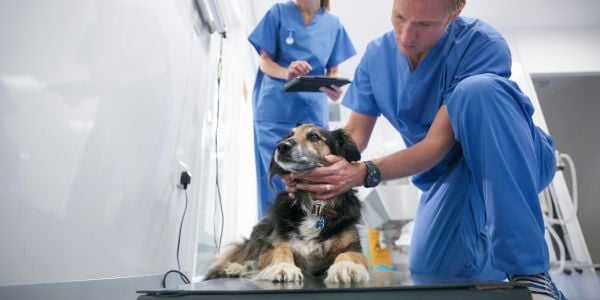
How to Diagnose the Cause of Your Pet Being Underweight?
If your pet is on a good quality diet and they are eating well, then it’s far more likely that their weight and muscle mass loss is due to one of the conditions in the list above. This means that a visit to your veterinarian is essential.
If your pet is underweight long-term, there is a risk to their quality of life as well as the fact that it can compromise their overall health (i.e., malnutrition, decreased immune function, poor healing, etc.). Certain conditions are more or less likely depending on your pet’s appetite, energy level, thirst, age, and a host of other factors.
Your veterinarian will need to get a complete history from you about your pet. This will help provide insight into what may be causing your pet’s weight loss. Some questions that you may be asked are the following:
- Has there been any change in your pet’s appetite? Has it increased, decreased, or remained the same?
- Have you noticed your pet consuming non-pet-food items, such as poop, rocks, or dirt?
- What kind of food are you feeding, and how much? Has there been any recent changes to the food or feeding schedule?
- Does your pet appear to be chewing and swallowing normally?
- Have you noticed any signs of nausea?
- Has there been any vomiting or diarrhea?
- Are they drinking and urinating normally?
- What medications, supplements, or preventative medications does your pet receive?
- Has your pet had a fever?
- Has your pet shown signs of weakness or changes in activity?
- Are any other pets sick in your home?
- Have you traveled with your pet anywhere in the last few months?
After your veterinarian has gotten a complete medical history, they will perform a physical examination as well as perform several diagnostic tests. Some of those tests may include a complete blood count, a chemistry panel, a urinalysis, intestinal parasite analysis, x-rays, and an ultrasound. Additional specialized blood tests may also be recommended.
Once your veterinarian has determined your pet's specific situation, they will lay out a plan to help provide your pet with the safest, most effective, and most practical treatments. Remember, the sooner you seek care for your pet, the better. Delaying treatment could cost them their life.
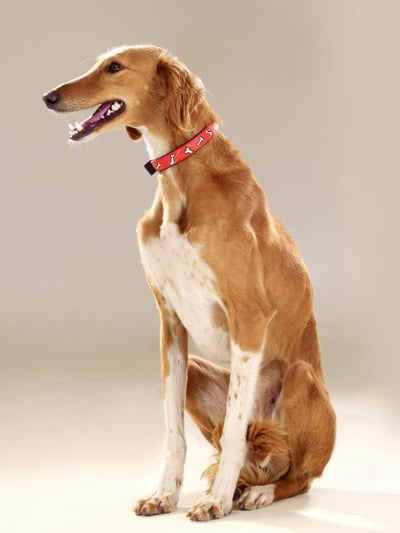
How to Prevent Weight Loss Issues?
Pets, especially cats, can hide illnesses and injuries very well. Diligently monitoring your pet’s body condition, muscle mass condition, and behavior, as well as visiting your veterinarian routinely, will alert you and your vet to conditions or illnesses that may be affecting your pet’s weight. Treatment of any condition or illness is easier in the early stages. The longer you wait, the harder your pet’s recovery will be, and the worse the potential long-term effects may be.
A critical component to helping your pet, regardless of age, is providing them with a balanced, high-quality diet that provides them with the nutrients they need to thrive. A proper balance of proteins, carbohydrates, fats, vitamins, minerals, and water is essential daily in order for their bodies to function properly. Read about how to choose a nutritious diet for your dog.
Every nutrient present in their food has an essential purpose. When these nutrients are poor quality or lacking, your pet cannot maintain muscle tone, nor can they build or repair muscle. They are unable to perform normal activities or are susceptible to infections. The following are just some benefits from the essential nutrients a balanced diet can provide.
Protein
Protein is what makes up every single cell in the body. It is needed in order for damaged cells to be repaired and for new ones to be made. It is a source of energy and an essential nutrient for the function and growth of muscles. Additionally, protein is needed to build hair, skin, organs, and other tissues. This particular nutrient is critical for growing pets and pregnant and lactating pets.
Note: This should be within the first few ingredients listed on your pet’s food label since it plays such an essential role in your pet’s overall health.
Carbohydrates
This quick source of energy also provides a source of fiber that helps with digestion.
Fats
Not only are fats a source of energy, but they are needed for proper brain function. They help your pet maintain healthy hair, coat, and skin.
Vitamins & Minerals
These are essential to help with muscle contraction and nerve conduction. They help support the immune system to help prevent disease as well as keep your pet’s metabolism functioning normally.

Helping Senior Pets With Weight and Muscle Loss
While we can’t stop the aging process that affects our older pets, we can slow the process down with proper nutrition, exercise, and supplements.
Each senior pet is unique and needs to be evaluated and treated as an individual. There is not one diet that suits all older pets. Nor does an exercise plan.
There are four important factors that you should consider when buying a senior diet. You need to look at:
1. Calories
Feeding the right amount needs to match up to your pet's weight – are they too fat or too skinny? Your veterinarian can help you determine how many calories per day your pet needs. For example, the average senior cat needs about 20 calories per pound of body weight (45 calories/kg of body weight), and the average senior dog needs about 25 to 30 calories per pound of body weight per day.
2. Protein
Seniors actually need more protein than adult dogs. The average healthy adult dog guideline is 2.55g protein/kg of body weight (BW) and 5g/kg BW for cats. Typically, senior pets may need this increased by as much as 50%. Speak with your veterinarian or a veterinary nutritionist for guidance. Read labels carefully and be sure the diet contains high-quality protein (preferably a meat-based source).
Note: If kidney disease is present, discuss the type and amount of protein your dog needs with your veterinarian. Protein (high amounts) does not cause kidney disease but has been found to cause progression if kidney disease is already present.
3. Omega-3 Fatty Acids
Some senior diets contain them, but with veterinary approval, additional supplementation is often needed. Omega’s help your senior pet maintain their skin, heart, kidneys, and joints. Studies are also showing they benefit your pet’s cognitive functions. Learn more about omega-3 fatty acids in fish oil supplements.
4. Fiber
Fiber is an important part of a senior pet’s diet. Not only does it aid in digestion, but it also allows them to obtain more nutrients from their diet. It helps them to feel fuller, which allows for a reduction in calories. Since senior pets are prone to constipation, fiber helps manage that, which means they are less likely to decrease their appetite due to discomfort and pain.
Exercise
Exercise is tremendously helpful for slowing the aging process in our senior pets. Try to incorporate exercises that help maintain strength, flexibility, balance, and mental enrichment. Exercise doesn’t have to be long and strenuous. Several short sessions throughout the day do just as well. Adapt the exercise plan to meet your pet’s mobility needs.
Cats can be more of a challenge than dogs, but it is entirely possible! Regular short walks, even inside, help maintain a healthy heart. Limiting your cat's access to jumping up and off of high surfaces is best as they age, but playing together using the prey sequence will challenge their brain and burn lots of energy.
As always, consult with your veterinarian on additional ways to help your senior pet live a vibrant life in their later years!
For ideas and therapies, read more about helping your aging dog's muscles and balance and this article for mobility-challenged cats.
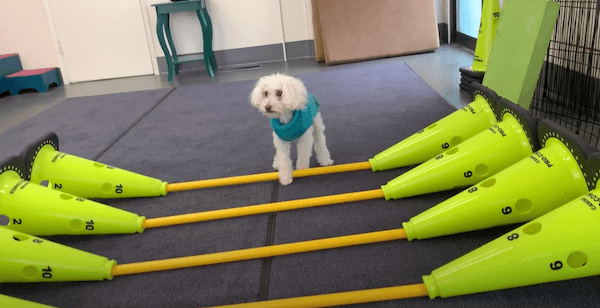
Calming Aids
Many senior pets suffer from stress and anxiety. People tend to get more nervous as they age, too. This stress in pets can cause them to eat less and have gastrointestinal issues that affect nutrient absorption and decrease their activity level (e.g., hiding in cats).
There are many ways to calm an anxious pet:
- The right kind of music can calm dogs.
- Sometimes, medications or supplements are needed for dogs.
- Giving your dog licking, smelling, or chewing activities can help.
- Playing using the prey sequence can help your cat with their stress.
- Helping your cat with their boredom will help.
- Helping your dog with their boredom will help.
- Composure treats for dogs and cats are supplements you can try.
- Using pheromone sprays or diffusers for cats may help.

If you're concerned that your pet is too thin, don't hesitate to ask your vet. They will put your mind at ease if there's no need for concern or help you identify the cause and the best course of action so that your pet can have a long, happy life.



